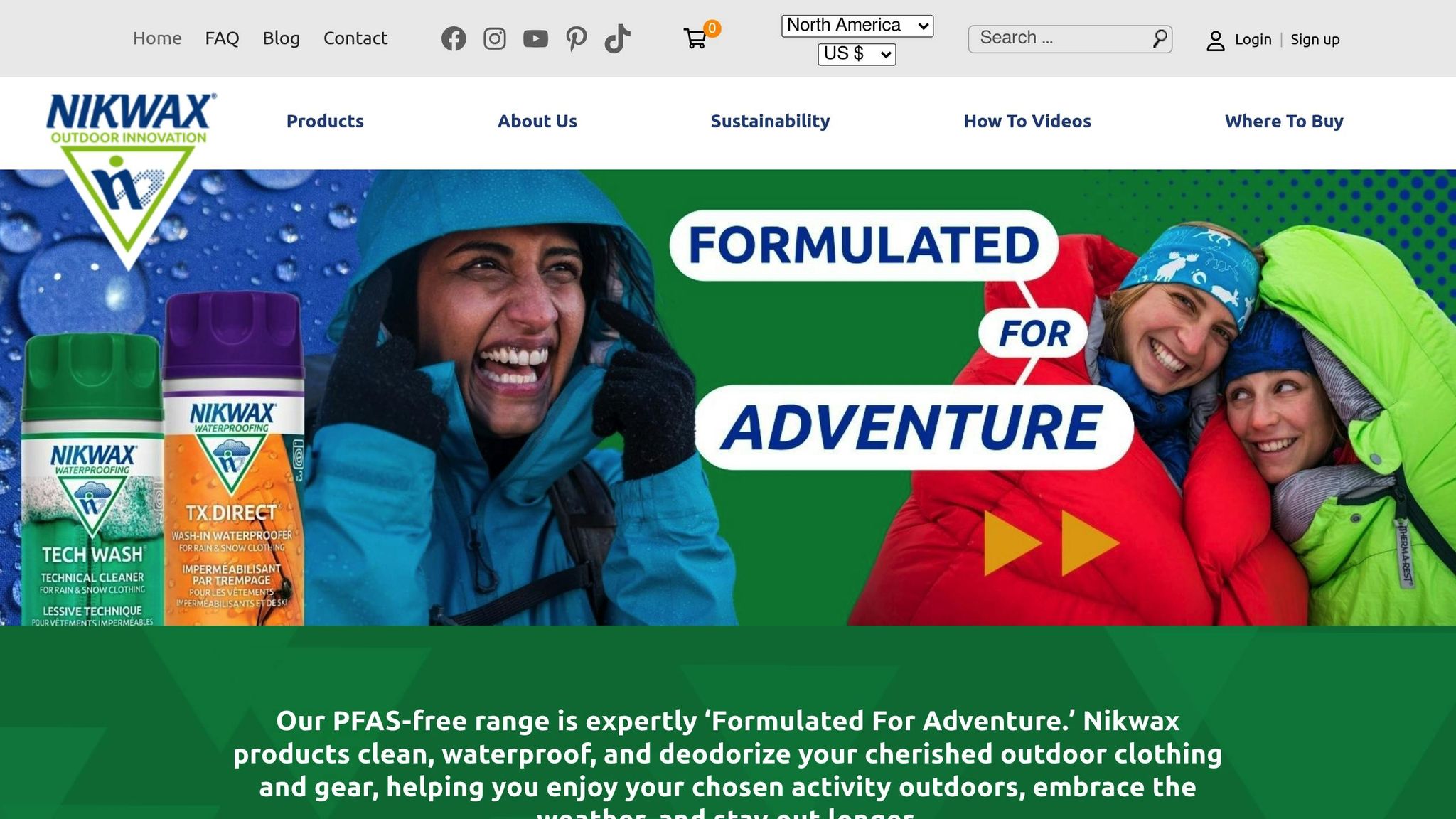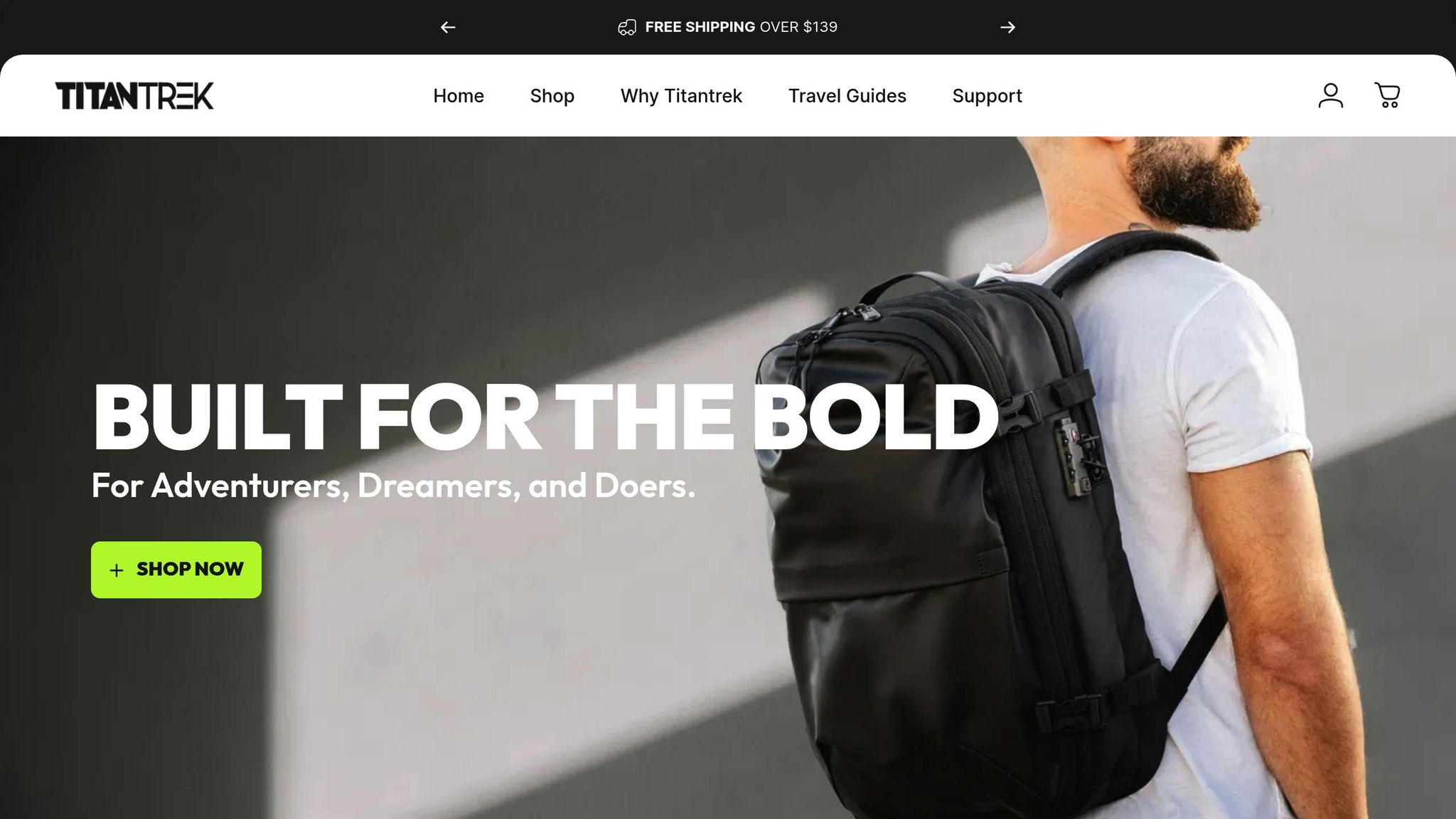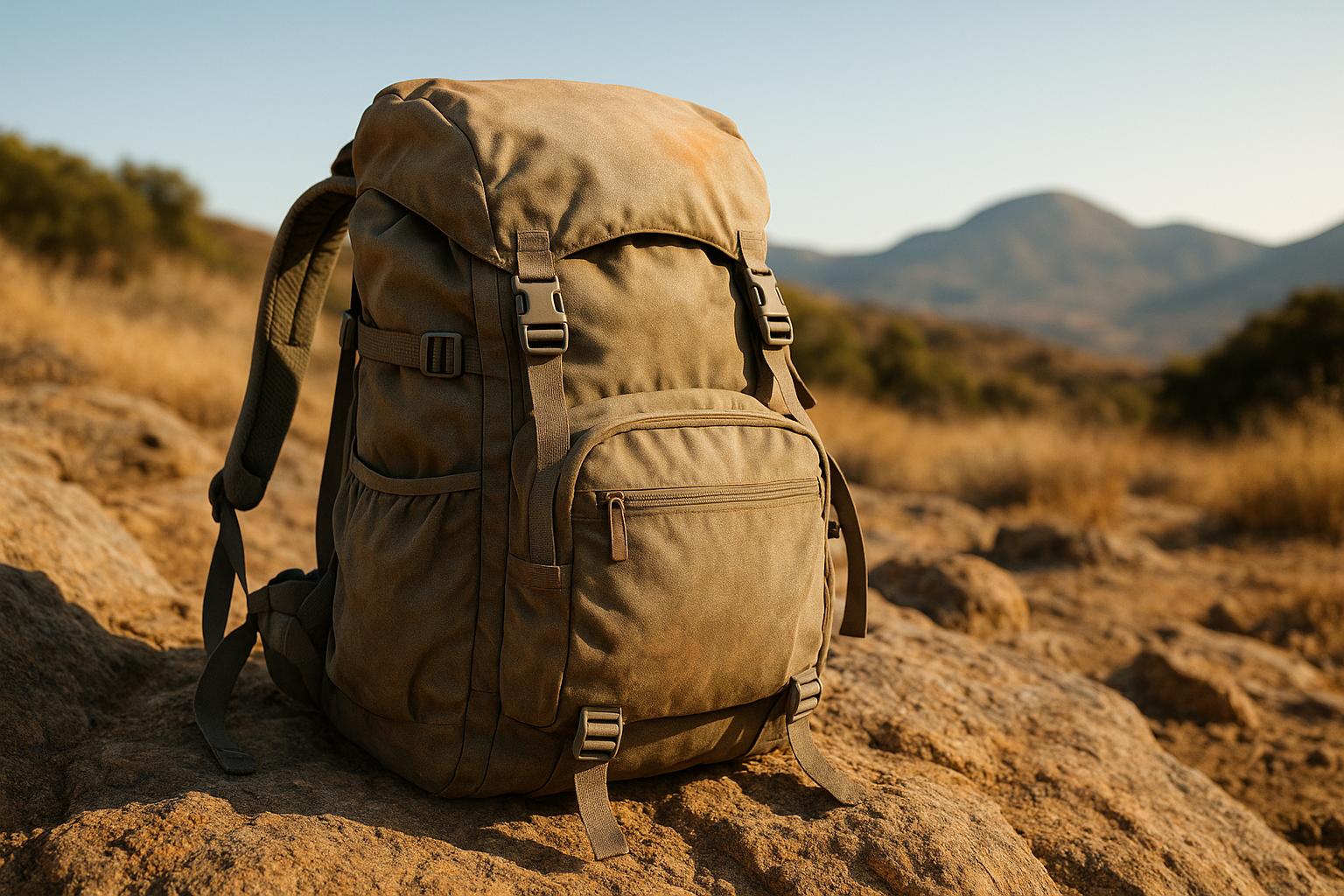When backpacks are exposed to sunlight, UV rays can weaken their materials, causing them to fade, crack, and lose durability over time. Here’s what you need to know:
- UV Damage: Prolonged exposure to UV rays breaks down the molecular structure of synthetic fabrics, making them brittle and less flexible.
- Signs of Damage: Look for color fading, surface cracks, texture changes, and reduced water resistance.
- Best Materials: UV-resistant fabrics, like those treated with special coatings (e.g., UV absorbers or titanium dioxide), last longer and maintain their strength.
-
Key Features to Look For:
- Dense synthetic weaves to block UV rays.
- UV-protective coatings to prevent damage.
- Reinforced stress points for added durability.
If you’re shopping for a backpack for outdoor use, consider UV-resistant options like the Titantrek Atlas Vault Vacuum Compression Backpack, which combines UV protection with long-lasting performance. UV-resistant gear not only lasts longer but also saves money in the long run.
Does Nikwax work? - Tent and Gear Solarproof - reproofer spray-on

UV Radiation Effects on Backpack Materials
UV radiation breaks down the molecular structure of backpack materials, altering their composition and reducing their performance over time.
How UV Damage Happens
When synthetic materials are exposed to UV rays, a photochemical reaction occurs, breaking molecular bonds in a process called photodegradation. This process impacts materials in several ways:
- Surface Damage: UV rays create microscopic cracks on the outer layer of fibers.
- Molecular Breakdown: Chemical bonds weaken, reducing the material's strength.
- Structural Changes: Fibers become brittle and lose their flexibility.
The severity of the damage depends on how intense and prolonged the UV exposure is. Over time, these molecular changes become visible and affect the material's usability.
Signs of UV Damage
Backpack materials show clear signs when they’ve been damaged by the sun. Here’s what to look for:
| Damage Type | Visible Signs | Impact on Performance |
|---|---|---|
| Color Fading | Fading or yellowing | Affects appearance |
| Surface Problems | Chalking or pitting | Reduces water resistance |
| Cracks or Tears | Visible structural damage | Weakens durability |
| Texture Changes | Rough or brittle feel | Limits flexibility |
Once the molecular structure is compromised, the material can’t regain its original properties. This is especially problematic for critical parts like shoulder straps and attachment points, which are crucial for a backpack's functionality.
To counter these issues, Titantrek integrates UV-resistant polymers into their materials. This approach improves durability and ensures better performance for outdoor use. The upcoming section will explore the results of material testing.
Material Testing Results
Laboratory tests have revealed varying levels of wear and tear among backpack materials when exposed to prolonged UV light. Researchers simulated extended outdoor conditions to assess changes in material strength, water resistance, and overall durability. The results highlighted consistent patterns of degradation in commonly used synthetic fabrics.
Material Performance Data
The tests showed that untreated materials break down more quickly. Nylon fabrics exhibited early loss of strength and water resistance, while ripstop polyester and polyaramid blends held up better over time. Fabrics treated with UV-resistant coatings lasted longer, showing delayed signs of wear and damage. These findings highlight the importance of protective treatments in improving material longevity.
Protective Treatments
UV-protective treatments have proven effective in extending the lifespan of backpack materials. Current coating technologies use a combination of:
- UV Absorbers: Chemical compounds that block harmful UV rays.
- HALS (Hindered Amine Light Stabilizers): Additives that slow down polymer breakdown.
- Titanium Dioxide Coatings: Reflective compounds that protect against UV radiation while maintaining material flexibility.
Titantrek's vacuum compression backpacks incorporate a proprietary UV protection system built on these technologies. This multi-layer treatment significantly reduces UV-related damage, helping backpacks maintain their structure and appearance even after extended sun exposure. The following section will explore UV-resistant materials and how they compare to untreated fabrics.
sbb-itb-b1567d8
UV-Resistant Materials
Advancements in material science now include treatments designed to reduce sun damage while keeping fabrics flexible. These treatments help protect against harmful UV rays without compromising the fabric's performance.
UV Protection Methods
Modern techniques use specialized coatings to block UV rays effectively. These coatings may include UV-blocking agents embedded directly into the fabric or applied through layered systems. This helps fabrics retain their color and structural integrity over time.
Treated vs. Standard Materials
Fabrics with UV protection hold up better against fading and weakening when exposed to sunlight compared to untreated materials. A great example is the Titantrek Atlas Vault Vacuum Compression Backpack, which combines UV protection with waterproof durability, making it ideal for outdoor use [1]. These advancements are especially beneficial for extreme conditions, setting the stage for the next section on choosing sun-resistant backpacks.
Selecting Sun-Resistant Backpacks
When it comes to backpacks for sunny environments, UV protection is a key factor. Backpacks with strong UV resistance not only last longer but also maintain their appearance and functionality under intense sunlight.
UV Protection Features to Look For
Here are the main elements to consider for effective UV protection:
- Dense Synthetic Weave: A tightly woven material helps block harmful UV rays while resisting wear and tear.
- UV-Inhibiting Coatings: Special treatments applied to fabrics act as a protective shield against UV degradation.
- Color Stability: Choose materials that balance UV protection with minimal heat absorption to avoid overheating.
| Protection Feature | Purpose | Benefit |
|---|---|---|
| Dense Weave Pattern | Blocks UV penetration | Prolongs material lifespan |
| UV-Inhibiting Coating | Acts as a protective barrier | Prevents fabric deterioration |
| Reinforced Stress Points | Reduces wear in exposed areas | Preserves structural strength |
These features are often found in top-tier backpack designs, ensuring durability in demanding conditions.
Titantrek's Approach to UV Protection

The Titantrek brand exemplifies these principles in its design. Take the Atlas Vault Vacuum Compression Backpack, for instance. It’s built with:
- Reinforced High-Exposure Areas: Strengthened sections to withstand intense sunlight.
- Weather-Resistant Fabrics: Materials specifically designed to defend against UV damage.
- Durable Hardware: Components that stand up to environmental wear and tear.
This combination of features ensures the backpack remains tough and reliable, even after prolonged exposure to harsh sunlight. It's a practical choice for outdoor enthusiasts who need gear that performs under pressure.
The Effects of UV Radiation on Backpacks
UV radiation can take a serious toll on backpack materials, affecting both their durability and appearance. Over time, prolonged exposure to sunlight weakens fabrics, leading to reduced strength and a worn-out look.
To combat this, using UV-resistant materials has become an effective solution. These fabrics not only help extend the life of a backpack but also ensure it performs well over time. A great example of this is the Titantrek Atlas Vault Vacuum Compression Backpack, which showcases how advanced UV-resistant materials can meet the needs of outdoor enthusiasts.
Here are some key advantages of UV-resistant materials:
- Longer Lifespan: Fabrics designed to resist UV rays stay strong and flexible, even after extended sun exposure.
- Cost Savings: Investing in UV-resistant materials upfront means your gear lasts longer, saving on replacement costs.
- Consistent Performance: Backpacks made with UV-resistant materials retain their functionality and reliability over time.
UV-resistant materials are a smart choice for anyone seeking gear that can handle the demands of outdoor adventures.
FAQs
How can I recognize UV damage on my backpack, and what steps should I take if it’s affected?
Prolonged sun exposure can weaken backpack materials over time, especially if they aren’t made from UV-resistant fabrics. Signs of UV damage may include faded colors, brittle or cracked fabric, and weakened stitching or straps.
If you notice these issues, consider limiting further sun exposure by storing your backpack in shaded areas when not in use. For severely damaged backpacks, it may be time to invest in a high-quality option made with UV-resistant materials, like those designed for durability and outdoor adventures. Regular cleaning and applying fabric protectants can also help extend the life of your gear.
What materials or treatments help backpacks resist damage from prolonged sun exposure?
Backpacks exposed to the sun for extended periods can experience fading, weakening, and other damage due to UV rays. UV-resistant fabrics are one of the most effective solutions, as they are specially designed to block or minimize UV radiation. Additionally, treatments like protective coatings can further enhance durability by reducing the material's vulnerability to sunlight. For adventurers, investing in gear made with these features ensures your backpack stays strong and reliable, even in harsh outdoor conditions.
How can I maintain the UV-resistant properties of my backpack over time?
To preserve the UV-resistant properties of your backpack, it's important to follow a few simple care tips. First, clean your backpack regularly using mild soap and water, avoiding harsh chemicals that could degrade the UV-resistant coating. Allow it to air dry in a shaded area rather than direct sunlight to prevent unnecessary exposure.
When not in use, store your backpack in a cool, dry place away from prolonged sun exposure. If you frequently use your backpack in sunny conditions, consider applying a fabric-safe UV protectant spray periodically to enhance its resistance. Proper care will help ensure your backpack stays durable and functional for years to come.

Analyzing Weight-to-Durability Ratios in Travel Gear
Air New Zealand Baggage Rules: What Not to Pack